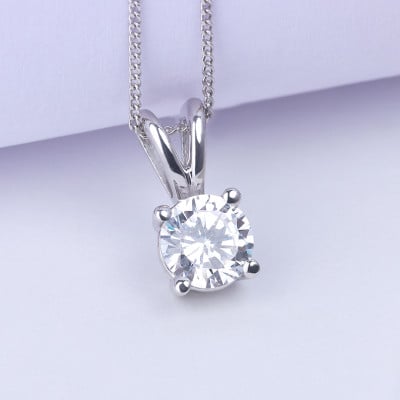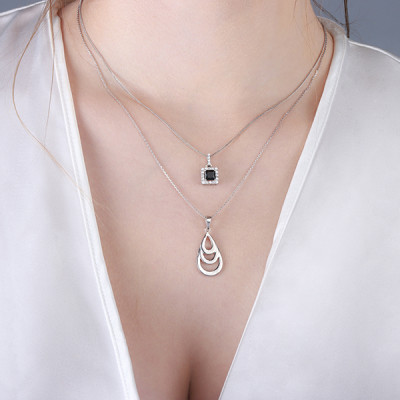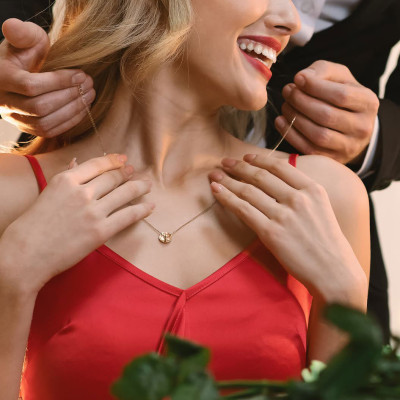Ultimate Diamond Necklace Buying Guide
1st August 2019 By Nilesh Rakholia
Quicklinks
There is no gift quite like a diamond necklace for any special occasion. It takes a keen eye to spot the very best diamond you can buy, so review the diamond very closely as you browse. You want a diamond to be right for the value, and one that gives off an impressive sparkle (brilliance, as we say in the industry) and size. Never choose a diamond from a vendor that doesn't have a reputation as unblemished as your ideal diamond, as you can never be sure of their trustworthiness. For style choices, consider the tastes and preferences of the recipient. There are various gold necklace designs, as well as options in other precious metals, and we will do our best to give you a rock-solid guide to them all here. Let's start with the basics:
Ultimate Diamond Pendant Buying Guide
As you have probably guessed, it is a necklace with a diamond in the center or cluster, attached by a tiny loop or sliding into a chain that is usually made from a precious metal like platinum or gold. The diamond, or diamonds, are usually set into a pendant using one of a range of setting styles, and there are lots of options to be considered for the chain itself. With various styles of a diamond necklace to choose from, the following is a general (but not exhaustive) list of what you might find:
Choosing the right diamond for your diamond solitaire necklace comes down to what the recipient's preferences are and, ultimately, what you can afford. There are, however, some rules that should be kept in mind regardless of what stone you are after. You should be looking for a well-balance between the quality of diamond, size, and price. Assess your diamond using the following parameters:

Certification : You should always look for a diamond with a GIA, IGI or EGL (Jewellery Certificate) certification. These grading entities are the most reputable, which means you get greater assurance that the quality you're promised is actually delivered. This is where all the specifications and characteristics of a given stone have been professionally assessed by a trained and fully qualified gemologist in controlled conditions. Read More
Cut : A well-cut diamond makes maximum use of the light that strikes its many pavilions. The result is that the light is reflected back through the table of the diamond and into the eye of the observer. The best-cut stones, depending on the shape and certifying body, are Excellent and Ideal. However, even if the vendor claims a diamond has this certification, you should still inspect it for yourself, prefeably through high-resolution imagery. If necessary, ask for expert help to inspect the stone. Read More
Colour : The colour of the white diamond refers to the lack of intrinsic colour found in a stone. Most diamonds will appear devoid of colour, but there will always be hints of either brown or yellow. There are some coloured stones, like the black diamond, but be warned that stones with a natural colour is often incredibly valuable - the most expensive blue diamond in the world, the Hope Diamond, is worth an estimated $350 million! Read More
Clarity : Since they are continuously in the line of sight of onlookers, clarity is of paramount importance in a diamond necklace. Again, close inspection of the diamond should reveal if there are any blemishes and inclusions visible to the naked eye. The amount of effect of diamond clarity depends on the size of diamonds also. Normally VS2 is eye clean diamond but smaller diamond also look eye clean in lower clarity grades. Read More
Shape : The most popular diamond shape for a solitaire necklace is the Round and Princess cut, but the Pear shape also has its fans. The shape you choose will have an impact on the setting style. The best advice is to consider several options and see which you think will work best. If you're having difficulty deciding, you can't go wrong with a well-cut Round diamond. Read More

Which type of setting is best?
There are various different setting styles for pendants and popular ones usually utilize prongs because they allow the maximum light to enter the diamond and create that dazzling sparkle. The most common type of pronged setting utilizes four prongs, but you will also find three-prong and six-prong settings give different style results. It's important that the setting you choose is suitable for the usage of the recipient will have for their necklace - prong settings may look great, but they can lack the durability for regular day-to-day use. The last thing you want is for the diamond to fall out of the necklace and get lost. Also Some popular alternative setting types include:

Channel Settings: multiple diamonds are set into a channel made out of a pair of metal strips - it's an attractive way to incorporate multiple stones. A diamond cross the necklace is often set using this method, creating a striking aesthetic that also portrays your spiritual beliefs.

Bezel Settings: an elevated metal collar wraps around the rim of the diamond for a complete metal edging - robust and durable enough for regular use, though you lose a little of the stone's sparkle since the metal blocks some of the light from getting to it.

Flush Settings: the diamond is set into a drilled hole in the pendant so that it sits 'flush' with the pendant surface - a very secure setting that minimizes the risk of the diamond chipping or falling out, though again the stone doesn't get as much light as it could.

Pavé Settings : a setting in which numerous small diamonds 'pave' the pendant - an elegant, timeless style that is dazzling to behold.
How do I choose the right chain?
There are various metal choices available for your chain and your pendant. Both 9K and 18K gold are robust enough for day-to-day wear, and gold colors include white, rose and yellow. Pendant chains can also be bought in platinum, though this usually pushes the price higher than necessary. You should bear in mind, however, that platinum is a popular contemporary choice in the modern market, though white gold does the job just as well. These colors are very popular for solitaire diamond necklaces today, but if the recipient prefers a more vintage aesthetic, the traditional look of yellow gold is a good way to go. Your decision should be made based on the recipient's preferences.
Abelini, we offer a choice of three chain link types:

The Cable Link: the most common jewellery chain, this is available in a wide range of widths and thicknesses. The links are oval-shaped, with an aesthetic not unlike the paper clip chains we all made in primary school. It's durable and versatile and doesn't kink easily.
The Curb Link : another common choice, this chain is similar in construction to the cable link, but the individual links are flatter in appearance. It's another durable chain, but it tends to be considered a more 'masculine' option, so makes a great choice for men's jewellery.
The Spiga Link : also known as the wheat link, this option comes in a range of widths and lengths that
never fail to look beautiful. The spiga link achieves a sparkle unlike any other, which differentiates it from the cable and curb link chain. It's another durable option that performs superbly as a gold necklace for women.
What type of clasp is best?
The two most common types of clasps are the spring ring and the lobster clasp. The spring ring is typically used for finer and more delicate chains. On the other hand, the lobster clasp is the preferred choice for heavier and thicker chains due to its durability, ease of use, and all-around safety. Lobster clasps are usually soldered onto the chain, making them a safer option compared to spring rings. Other clasp options include:
● S-Hook - A solid and reliable choice.
● Figure-Eight Safety Catches - These are excellent but not available for all chain types.
● Magnetic Clasps - Easy to put on and take off, but there is a risk of losing your necklace.
Hook Clasps feature a simple and dependable design that does not require additional fastening. With their recognizable “S” shaped hook and “O” shaped receiving end, hook clasps are popular for their effortless clasping qualities.
Lobster Necklace Clasps resemble a lobster claw and include a delicate lever that retracts to allow one side of the necklace to attach to the other. These clasps are favoured for their simplicity and security.
Spring Ring Necklace Clasps have an “O” shaped ring with a small lever along its edge. The lever retracts to open part of the ring, allowing the other end of the necklace to attach. They are slightly more delicate than lobster clasps but equally secure, making them ideal for those with precise hands.
Slide Necklace Clasps are popular in multi-strand necklaces and consist of two bars on each end that slide and lock together. They are secure and simple, ideal for heavier, more extravagant necklaces.
T-Bar Necklace Clasps feature a circular ring on one end and a T-shaped piece on the other. The T-shaped piece is inserted into the circular ring to secure the necklace. While popular in more delicate designs, this clasp style may be less secure than lobster and spring ring clasps.
Magnetic Necklace Clasps offer a functional design that provides an efficient and straightforward way to secure your jewellery. They connect instantly with quality magnets, offering the necessary security for everyday wear.

What other important considerations are there?
It's vital that you establish whether the chain is hollow, solid, semi-solid or plated. If, for example, you buy a 9kt yellow gold chain with 18kt gold plating, the chain will look more yellow and rich... at least, to begin with. Plating always wears off eventually, so if you want the chain to look its best for the long term, this may not be the best option to choose.
Hollow chains, sometimes known as 'semi-solid, look the same as other chains but are usually much lighter when you hold them. That's because the inside of the metal in each link is hollow to reduce the price. You'll find lots of thick-looking chains are made this way, and the problem is that hollow chains are usually quite brittle and prone to breaking. They are also more prone to denting, and it isn't easy to fix them to a satisfactory standard.Solid chains are the way to go because they are more likely to last a lifetime. In a necklace, there are many moving parts that are constantly rubbing together as you go about your business. A solid chain will hold up best against wear and tear, so it is the best option for the long term. Look for chains that the vendor sells with a guarantee - if they're willing to back their product, that can be a great indication of their confidence in the craftsmanship. Look closely at the guarantee, however, as it may only ensure the product is free from manufacturing defects, and not offer any cover for wear and tear/breaking.
Which chain length should I choose?

The standard chain length for a diamond necklace with a pendant is 16 inches, but there are other options available. The 16-inch option is usually correct for leaving the pendant resting nicely on the collarbone, but there will be variations in people's neck/shoulders that can have an impact on this. If you want a little flexibility in the length, you can choose a longer chain with jump rings. These types of chains have two rings towards the end of the chain, set an inch or so apart, giving you the ability to adjust the chain from, for example, 18 inches to 16 inches. This makes a necklace more versatile and is a good option for some.
At Abelini, we offer a wide selection of chain lengths to give you a range of options depending on practical considerations and also style choices. For some people, a chain which causes the pendant to hang lower is a classy, traditional aesthetic that fits their needs well. For this, we offer 30-inch chains that hang around the diaphragm, and even 36-inch ones that hang down to the navel. There are also chains that range from 17 inches through to 24, so you have no shortage of options to find the length that works for you. For more details, you can check out our necklace size guide.
When should you buy a diamond necklace?
A beautiful diamond necklace makes a stunning and memorable gift. With their timeless design and effortless appeal, diamond necklaces are commonly kept as family heirlooms, passed down from one generation to the next. Few items of jewellery look quite as impressive and breathtaking as a diamond necklace, and the recipient of a gift will be proud to wear their new necklace at dressy events, celebrations or even just their day-to-day life. Consider buying a diamond necklace as a gift for any of the following special occasions:
Wedding anniversary: Reserve this gift for landmark anniversaries like the 5th, 10th, 15th, etc. It can be a great way to mark a special milestone in your life with your partner
Birthday: Again, landmark birthdays like someone's 21st, 30th, 50th or 70th are ideal for such a luxury gift. Of course, if you like to treat your loved ones, a diamond necklace will be a welcome gift for any birthday.
Valentine's Day: Spoil your loved one on the most romantic of days by sweeping them off their feet with a beautiful diamond necklace that will help cement your special place in their heart. Speaking of which, a heart necklace with diamonds can be a perfect choice for a Valentine's Day gift!
Graduation: Let them know how proud you are of their achievement with the gift of a beautiful diamond ring that they can cherish throughout their journey into adulthood.
Retirement: Mark this important occasion with a gift that represents the true value of their life's work. A diamond necklace will show that you recognise all they have achieved, and provide a gift to be loved throughout those restful retirement years.
A promotion at work: Getting promoted can be a huge achievement for anyone, and with the gift of a diamond necklace you can show someone you care about that you cherish and admire them for their achievement.
These are just a few suggestions of occasions where a diamond necklace can make an excellent gift. There are many others, but the bottom line is that a diamond necklace is a powerful way to express fondness or appreciation for a loved one. If you want to tell them you love them with a special gift, this could be the ideal way to do it. Just make sure you follow the advice of this guide carefully to ensure you are getting the very best diamond necklace for the occasion and the person. There are various pitfalls to be avoided throughout the process of buying a diamond necklace, and by following our guide you will be able to avoid them and get a quality, elegant product that will make the recipient happy for years to come.

Article written by Nilesh
 Trustpilot
Trustpilot



